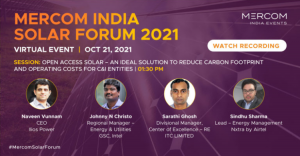Mercom hosted a session on ‘Open Access Solar – an Ideal Solution to Reduce Carbon Footprint and Operating Costs for C&I Entities’ at ‘Mercom India Solar Forum 2021’ on October 21, 2021.
The panelists in the session discussed the future demand, policy support, and the enabling environment needed to make open access favorable to all.
The panelists included Naveen Vunnam, CEO, ILIOS Power; Johnny N Christo, Regional Manager – Energy & Utilities GSC, Intel; Sarathi Ghosh, Divisional Manager, Center of Excellence – RE at ITC Limited; Sindhu Sharma, Lead – Energy Management, Nxtra by Airtel.
Corporate consumer demand for open access
During the discussion, Naveen Vunnam pointed that, “The lower solar tariff gives C&I consumers an attractive option to shift towards renewable energy from fossil fuels to push towards their carbon neutrality goals. In addition, C&I companies are not taking any half-measures towards achieving 50 GW open access capacity, which is a positive sign for the sector.”
Echoing similar thoughts, Sarathi Ghosh said ITC was one of the first companies to develop inter-state open access projects. ‘These projects provide financial benefits for the company. However, ITC’s primary driving force towards shifting to open access is its commitment to sustainability. We have around 80 MW capacity in the pipeline across various states, but the pandemic delayed most of our projects,’ he added.
“Currently, our data centers are procuring 35% energy from renewables. Our power needs will be doubled in the next three-four years,” said Sindhu Sharma. “Therefore, we are in talks with developers to procure more solar power through open access and maintain renewables proportion in energy consumption. We are planning to have open access project that supplies solar energy across states.”
In April 2021, Bharti Airtel announced it would begin sourcing power from a 14 MW captive solar project to meet the energy requirements of its data centers in Uttar Pradesh.
However, Johnny N Christo said Intel is taking very measured steps towards procuring open access solar due to a lack of consistent policy and volatile cross subsidy surcharges. Currently, Intel procures 6-8% of its power demand through open access solar projects for its data centers.
 Policy challenges
Policy challenges
The demand for procuring renewables in the open access market is increasing every quarter, indicating the market’s high potential. Corporates are trying to match their power demands through renewable sources.
ITC’s Sarathi said the average life of solar and wind projects is around 25 years. Therefore, developers and consumers need long-term and stable policies to invest in open access projects. However, every state has different open access policies, and they keep on adding new charges or increasing existing ones. This discourages consumers from opting for open access solar projects.
Similarly, Sindhu said, “We plan to transfer power from our open access projects to data centers in other states. We request the government remove inter-state transmission system charges to encourage consumers to increase renewable power procurement from open access projects. In addition, the current one-year tariff period in most states does not provide any certainty to consumers.”
Echoing similar thoughts, Naveen said unpredictable cross-subsidy charges and other surcharges are significant barriers to open access solar project developers and the market’s growth.
The speakers agreed that implementing a multi-year tariff across states would provide developers certainty on the policy front to help the Indian market grow.
Banking of energy
Sarathi stated, “Banking is essential for C&I consumers as they need 24/7 power. To procure 100% power of open access solar sources, they require banking until storage technologies become commercially viable in India. However, there is no comprehensive policy for banking, and therefore, open access projects have to downsize their generation capacity.”
Naveen agreed with Sarathi and said banking is the major challenge for open access developers and consumers. In addition, states are making it more difficult with irregular non-concrete policies.
In August 2021, the Ministry of New and Renewable Energy proposed that the quantity of banked power by the green energy open access consumers would not be over 10% of their total annual power consumption from DISCOM. It said banking might be permitted every month on payment of charges to compensate the DISCOMs for any additional costs.
The panelist agreed that regulations across states, long-term policies without retrospective changes, and concrete banking policy are necessary for the open access market.
In the first half of 2021, India added 628 MW of open access solar capacity, a 12-fold (1,230%) growth compared to 47 MW installed in 1H 2020. India’s cumulative open access solar installation stood at 4.5 GW at the end of June 2021.
Commercial and industrial (C&I) establishments across the board are sourcing solar through open access to meet their commitment to sourcing renewables and mitigating climate change.
Click here to view a recording of this panel discussion.
Concrete Banking Rules and Uniform State Policies Key to Open Access Solar Growth
Multi-year tariff and concrete banking policy can attract C&I consumers towards open access solar market
Source:MERCOM
ViaHarsh Shukla





